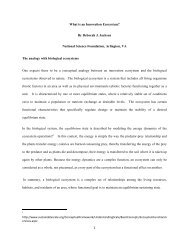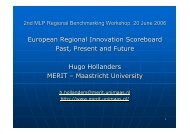Creating smart systems, guide to Cluster strategies in less favoured
Creating smart systems, guide to Cluster strategies in less favoured
Creating smart systems, guide to Cluster strategies in less favoured
You also want an ePaper? Increase the reach of your titles
YUMPU automatically turns print PDFs into web optimized ePapers that Google loves.
A GUIDE TO CLUSTER STRATEGIES IN LESS FAVOURED REGIONS | 7<br />
III. What makes <strong>Cluster</strong>s Grow<br />
Why is one cluster more successful than another <strong>in</strong> <strong>less</strong> advantaged regions Even<br />
hold<strong>in</strong>g market conditions constant, some clusters, for example, fare better because they<br />
are able <strong>to</strong> <strong>in</strong>novate and develop new comparative advantages or perhaps because they<br />
have the foresight <strong>to</strong> shift their competencies <strong>to</strong> new markets. Rosabeth Moss Kan<strong>to</strong>r has<br />
attributed economic success <strong>to</strong> three fac<strong>to</strong>rs: concepts, connections, and competencies. 1<br />
A. Concepts<br />
Innovation, imitation, and entrepreneurship are what propel virtually all competitive<br />
clusters. While the success of an <strong>in</strong>dividual firm may depend on its ability <strong>to</strong> protect its<br />
own technological advances, new products, or designs, the success of the cluster <strong>in</strong> which<br />
it operates depends on the opposite—widespread diffusion, access <strong>to</strong> new <strong>in</strong>novations<br />
and <strong>in</strong>formation, and sp<strong>in</strong>-offs of new enterprises. The porosity of clusters presses<br />
competi<strong>to</strong>rs with<strong>in</strong> the cluster <strong>to</strong> cont<strong>in</strong>ually improve and <strong>in</strong>novate <strong>in</strong> order <strong>to</strong> ma<strong>in</strong>ta<strong>in</strong> their<br />
advantages over imita<strong>to</strong>rs.<br />
Innovation. Innova<strong>to</strong>rs generate and commercialise new ideas, f<strong>in</strong>d more efficient<br />
production processes, or create new markets. Although university and advanced research<br />
centre-based R&D attract much of the resources and attention of governments, many of<br />
the most valuable <strong>in</strong>novations are improvements <strong>in</strong> bus<strong>in</strong>ess and production rout<strong>in</strong>es<br />
devised by employees, such as <strong>in</strong> applications of exist<strong>in</strong>g technologies, design of<br />
production and management <strong>systems</strong>, market<strong>in</strong>g of products, and organisation of labour.<br />
Cus<strong>to</strong>mers, suppliers, competi<strong>to</strong>rs, and <strong>to</strong>ol builders are important sources of these<br />
<strong>in</strong>novations. The current competitive advantage of Italy’s ceramic tile companies, for<br />
example, is largely a result of relationships between equipment manufacturers and users.<br />
Imitation and competition. Innovation builds a strong company but imitation and the<br />
competition that follows generate the scale for a strong cluster. Imitation is as important <strong>to</strong><br />
a cluster as <strong>in</strong>novation because it’s what circulates new concepts and practices among<br />
companies and spurs further <strong>in</strong>novation. It is the reason that companies look for<br />
benchmarks among their peers. Many of the imita<strong>to</strong>rs become <strong>in</strong>nova<strong>to</strong>rs by improv<strong>in</strong>g<br />
upon the practices they adopt and this cycle of <strong>in</strong>novation and imitation drives clusters<br />
<strong>to</strong>wards excellence. If a cluster has a collective persona and its markets are global, it<br />
views imitation as strengthen<strong>in</strong>g the cluster.<br />
Entrepreneurial energy. Entrepreneurial capacity is the fuel that drives the expansion of<br />
the cluster growth. Recruitment may be a vitam<strong>in</strong> regimen that fortifies it, but it’s the rare<br />
location that can recruit a cluster. The genesis of most clusters can be traced <strong>to</strong> the<br />
employees of one or two companies who left <strong>to</strong> start their own companies. The impetus <strong>in</strong><br />
some cases was survival when a parent firm downsized, or went out of bus<strong>in</strong>ess, or<br />
moved. The hosiery firms <strong>in</strong> Italy’s Castle Goffredo were established by skilled workers of<br />
the German-owned company Noemi who, when the firms decl<strong>in</strong>ed <strong>in</strong> the 1950s, bought<br />
surplus equipment and became entrepreneurs. But a more common stimulus for<br />
entrepreneurs has been <strong>to</strong> exploit a different niche market, become an <strong>in</strong>dependent<br />
1<br />
Rosabeth Moss Kan<strong>to</strong>r, World Class, New York: Simon & Schuster, 1995.
















